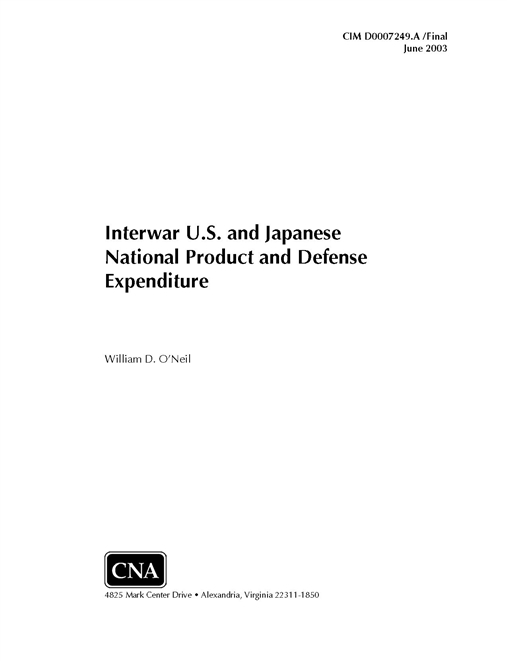Background
This memorandum documents the derivation of estimates of Japanese and U.S. economic resources and of their application to military purposes between the two world wars.
Data sources
Japan and its colonies
As the first extra-Western economy to match Western standards of performance, Japan has come in for special scrutiny from economists and economic historians. While much of this work has been done by Japanese economists and published in Japanese, the mate- rial available in English is extensive and adequate for the purposes of this effort.
As the concepts and procedures of national income accounting developed in the 1930s and 1940s, various efforts were made to apply them to Japan. These are summarized in a study of the Japanese economy published following the war by Jerome Cohen, an economist associated with the United States Strategic Bombing Survey (USSBS). The USSBS itself studied the Japanese economy in the wartime years and published estimates of wartime national product.
The USSBS efforts were bedeviled by inadequacies in the source records, wide scale destruction of records in the war and immediately following it, and Japanese official secrecy. While these obstacles have not been altogether eliminated, subsequent research has done much to minimize their effect.
Beginning in the 1960s, a major effort by Japanese economists led to the publication of a comprehensive 14-volume series covering all aspects of Japanese historical statistics. This was published in Japanese, but has English summaries and table headings and is usually cited as LTES (Estimates of Long-Term Economic Statistics of Japan). A further volume published in English by the same group, Patterns of Japanese Economic Development (PJED), summarizes the results and in a few cases revises them somewhat. More recently, Toshiyuki Mizoguchi and Noriyuki Nojima have published revised estimates for pre-war Japan and its colonies. The same authors have also published estimates for the war years separately. I have relied primarily on data from Mizoguchi and Nojima.
Fortunately for our purposes, economists studying Japan have seen military expenditure as an important part of the picture. Naturally, these efforts have been especially affected by records destruction and official secrecy, but a reasonably satisfactory picture has emerged, at least for the years prior to World War II.
In an early study of Japanese capital formation, Henry Rosovsky paid careful attention to Japan’s investments in military capital, ar- guing that this served both statistical clarity and history. Koichi Emi, who had collaborated with Rosovsky, revised the earlier study’s estimates for his volume on capital formation in the LTES series. As Emi does not include as much detail on the composition of military capital, however, I have drawn on Rosovsky’s work as well as his. LTES and PJED provide data on total defense expenditures.
Takafusa Nakamura, in his study of economic development before World War II, includes statistics from a variety of Japanese-language studies which have been useful in filling in certain parts of the picture.
Download reportCleared for public release; distribution unlimited.
Details
- Pages: 64
- Document Number: CIM D0007249.A /Final
- Publication Date: 6/1/2003
